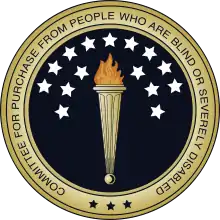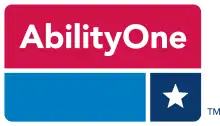Javits–Wagner–O'Day Act
The Javits–Wagner–O'Day Act 41 U.S.C. § 46 et seq. is a U.S. federal law requiring that all federal agencies purchase specified supplies and services from nonprofit agencies employing persons who are blind or have other significant disabilities. The Act was passed by the 92nd United States Congress in 1971.

History
The act is named after its sponsor, Senator Jacob K. Javits, and the Wagner–O'Day Act, passed by the 75th United States Congress in 1938, which had been named after Senator Robert F. Wagner and Congresswoman Caroline O'Day.[1]
Javits led the efforts to expand the older law, which was called the Wagner–O'Day Act, and which mandated that federal agencies purchase products from workshops for the blind meeting specific qualifications.[2][3] The effort for expansion succeeded in spite of objections raised by organizations representing the blind, as expressed for example in Resolution 68-04[4] passed in 1968 by the American Council of the Blind.
Program administration

The federal agency charged with administering the program is currently known as the Committee for Purchase from People Who Are Blind or Severely Disabled. It replaced the Committee on Purchases of Blind Made Products established by the 1938 act. The agency decides which commodities and services the government should purchase under the Javits Wagner O'Day Act. The program it oversees, known for over three decades as the Javits Wagner O'Day Program, was renamed "AbilityOne" by Congress in 2006.[5] The Committee is composed of fifteen Presidentially-appointed members, eleven of whom represent governmental agencies (Department of Agriculture, Air Force, Army, Commerce, Defense, Education, Justice, United States Department of Labor, Navy and Veterans Affairs, and the General Services Administration). The remaining four members are private citizens knowledgeable about the employment problems of people who are blind or have other severe disabilities, including those employed by nonprofit agencies affiliated with the AbilityOne Program.[6]

The Committee has designated two national nonprofit associations NPAs to assist with the program implementation and execution: the National Industries for the Blind (NIB) and SourceAmerica, formerly known as National Industries for the Severely Handicapped (NISH). More than 600 NPAs associated with either NIB or SourceAmerica produce products and services under the AbilityOne Program. The core criteria for NPA eligibility is that 75% of total direct labor hours must be performed by people who are blind or have other significant disabilities.[7] The AbilityOne Program is the largest employment resource for people who are blind or have other significant disabilities, helping to employ more than 40,000 people.
Federal Investigations
The Javits-Wagner-O’Day Act is itself a product of Franklin D. Roosevelt’s New Deal policies from 1933-1938. The Wagner O’Day act was signed into law on June 25, 1938, and required that all government agencies prioritize the purchasing of products to suppliers that employ individuals who are blind. The Javits–Wagner–O'Day Act expanded the law, requiring specified supplies and services come from nonprofit agencies employing persons who are blind or have other severe disabilities. The Act was passed by the 92nd United States Congress in 1971.[8]
Federal Investigations surrounding the AbilityOne program, and its central non-profit agency SourceAmerica,[9] mirror the problems highlighted by Roosevelt’s failed National Industrial Recovery Act. The NIRA tossed away antitrust laws and suppressed competition by creating monopolies. These policies continued even after the NIRA was declared unconstitutional in 1935.[10]
See also
- Randolph–Sheppard Act of 1936, mandating that the blind be given precedence over the operation of vending facilities on Federal property
- ARC Diversified
- The Lighthouse for the Blind
- Travis Association for the Blind
References
- Ronald Reagan: Proclamation 5835—50th Anniversary of the Javits-Wagner-O'Day Act, 1988
- Jill Sardegna; Susan Shelly; Scott Steidl (2002). The Encyclopedia of Blindness and Vision Impairment. Infobase Publishing. pp. 127–. ISBN 978-0-8160-6623-0.
- Jill Sardegna; Susan Shelly; Scott Steidl (2002). The Encyclopedia of Blindness and Vision Impairment. Infobase Publishing. pp. 162–. ISBN 978-0-8160-6623-0.
- American Council Of The Blind Archived 2007-09-28 at the Wayback Machine
- "About Us - A Brief History of the AbilityOne Program". Archived from the original on 2010-08-19. Retrieved 2010-04-05.
- "Committee for Purchase From People Who Are Blind or Severely Disabled - The Committee". Archived from the original on 2011-04-11. Retrieved 2010-04-05.
- 41 USC Section 8501
- "History". www.abilityone.gov. Retrieved 2016-05-29.
- Investigations, Scott Bronstein, Drew Griffin, and Curt Devine CNN. "Feds open investigation after CNN reports". CNN. Retrieved 2016-05-29.
- Cole, Harold L.; Ohanian, Lee E. (2009-02-02). "How Government Prolonged the Depression". Wall Street Journal. ISSN 0099-9660. Retrieved 2016-05-29.